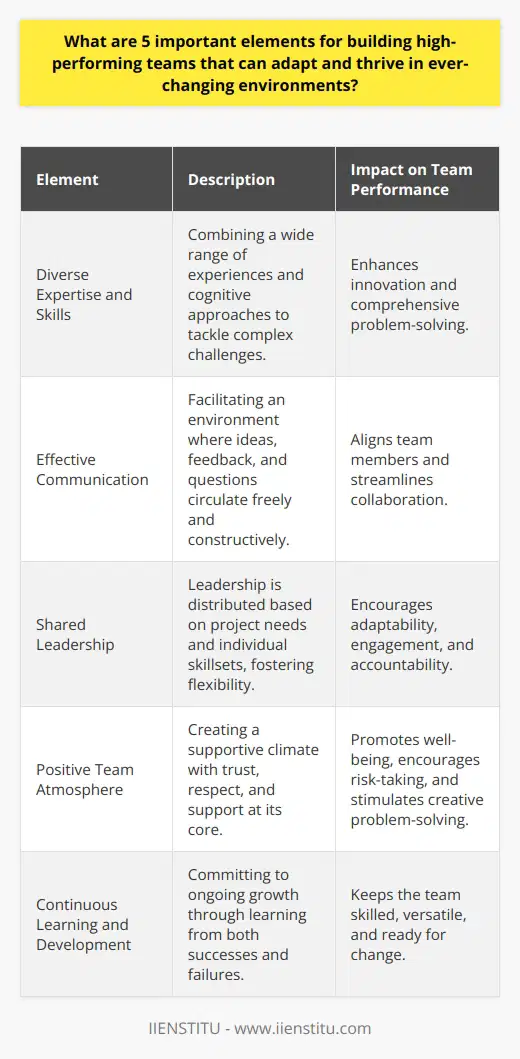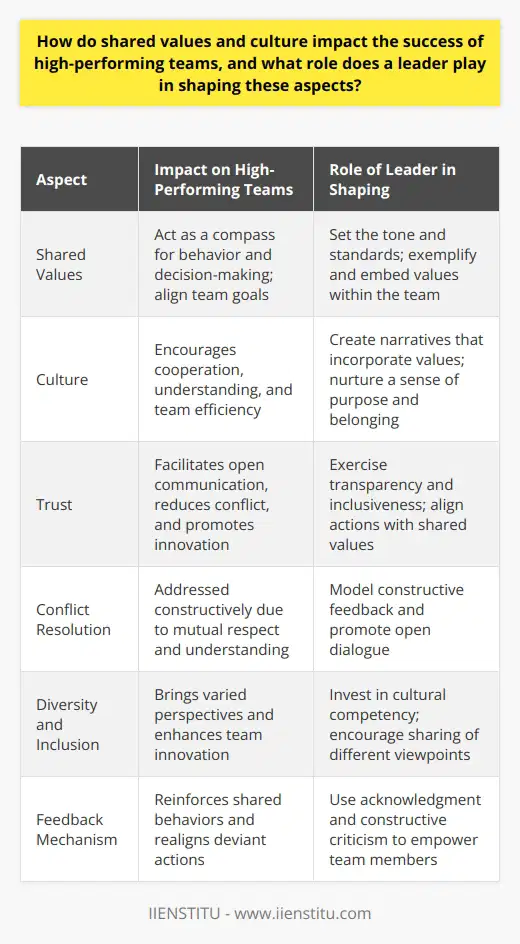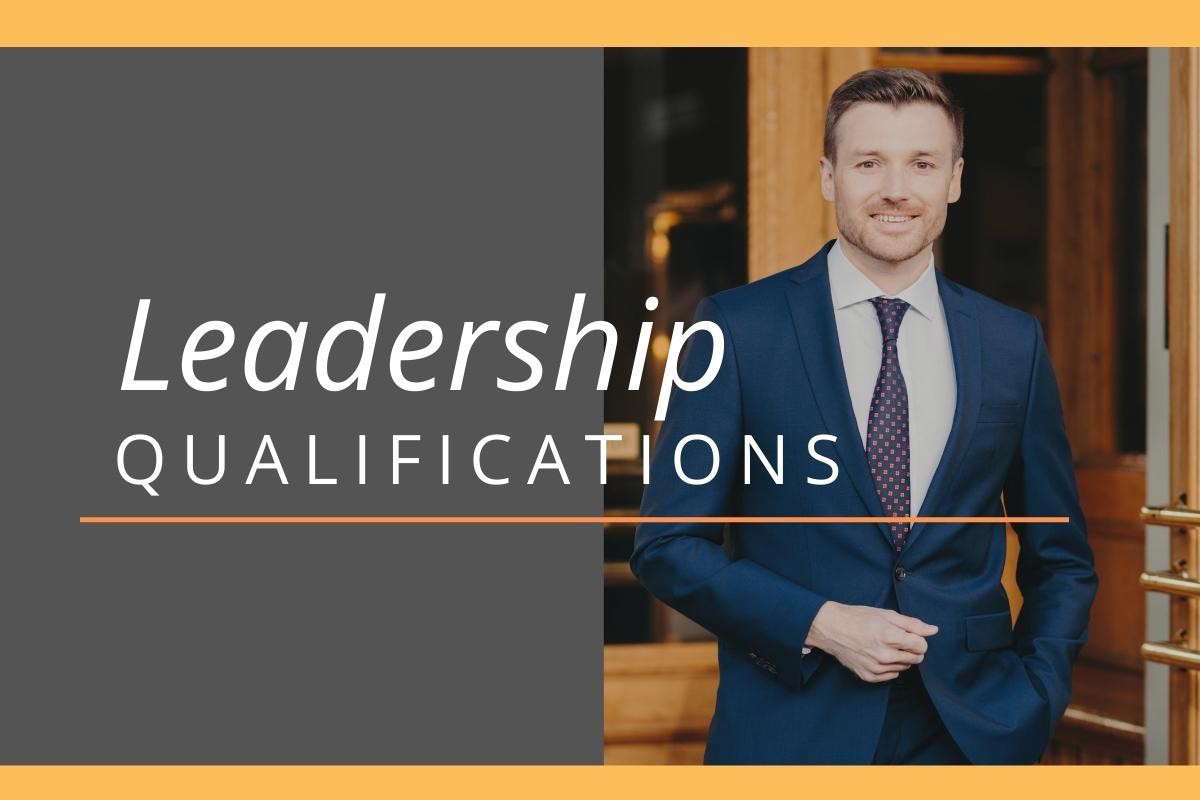
This article provides an overview of the four elements of the talent agenda that executives should consider when transitioning into a new role. These elements include assessing the inherited staff, building a high-performing leadership team, designing a future-ready organization, and understanding the time-talent trade-off. By taking the time to consider these four topics, executives can ensure they are setting themselves up for success.
Related Course: Leadership Development Course
Introduction
Assessing the Inherited Staff
Building a High-Performing Leadership Team
Designing a Future-Ready Organization
Time-Talent Trade-Off
Introduction: When transitioning into a new executive role, one of the most important elements to consider is the talent agenda. This agenda should include assessing the inherited staff, building a high-performing leadership team, designing a future-ready organization, and understanding the time-talent trade-off. This article will provide an overview of these four topics and discuss how they can be used to ensure a successful executive transition.
Assessing the Inherited Staff
When transitioning into a new executive role, it is essential to assess the inherited staff. This assessment should include determining who can deliver critical priorities and who may need reassigned or recruited. Assessing the current staff’s skills, experience, and knowledge is also essential. This will help to ensure that the right people are in the right seats.
Building a High-Performing Leadership Team
Once the inherited staff has been assessed, building a high-performing leadership team is essential. This team should be composed of individuals capable of working together to achieve the organization’s goals. It is also essential to establish a culture of collaboration and trust. This will help to ensure that everyone is working toward the same objectives.
Designing a Future-Ready Organization
To ensure success in the long-term, it is essential to design a future-ready organization. This means that the organization should be designed to serve best the current leader, as well as the future needs of the company. It is essential to consider the organization’s structure, processes, and systems to ensure they align with the company’s objectives.
Time-Talent Trade-Off
Finally, it is essential to understand the time-talent trade-off. This means that to be successful; executives must be willing to invest time and energy into developing their team. This includes providing training, mentorship, and feedback. It also means that executives must be willing to invest their own time and energy into developing their skills and knowledge.
Conclusion: In conclusion, it is essential to consider the talent agenda when transitioning into a new executive role. This includes assessing the inherited staff, building a high-performing leadership team, designing a future-ready organization, and understanding the time-talent trade-off. By taking the time to consider these four topics, executives can ensure they are setting themselves up for success.
Leadership is not about being in charge; it's about empowering others to achieve success.

Frequently Asked Questions
What strategies can be used to assess the inherited staff when building a high-performing leadership team?
When building a high-performing leadership team, it is essential to assess the inherited staff to determine their strengths and weaknesses and build upon them to create a successful team. Several strategies can be used to assess the inherited staff, including individual evaluations, performance reviews, interviews, and surveys.
Individual evaluations are an effective way to assess the inherited staff by providing an opportunity for each team member to reflect on their performance and identify areas for improvement. This can be done through self-assessment tools, such as a skills assessment, where team members can identify their strengths and weaknesses, or a 360-degree feedback process collected from peers and colleagues.
Performance reviews are another tool that can be used to assess the inherited staff. These reviews can provide insights into the team member's performance and provide a basis for further development. During the performance review process, it is essential to focus on the team member's strengths and areas that need improvement.
Interviews can also be used as a way to assess the inherited staff. These can be structured interviews, where team members are asked predetermined questions, or unstructured interviews, where team members are asked open-ended questions about their experiences and opinions. Interviews can provide valuable insight into the team member's strengths and weaknesses and their attitude and commitment to the team.
Finally, surveys are an effective way to assess the inherited staff. Surveys can provide a comprehensive view of the team member's performance. They can be used to gain feedback from the team members on various topics, such as job satisfaction, team dynamics, and communication.
In conclusion, several strategies can be used to assess the inherited staff when building a high-performing leadership team. These strategies include individual evaluations, performance reviews, interviews, and surveys. Using these strategies, it is possible to gain valuable insight into the team member's strengths and weaknesses and their attitude and commitment to the team.
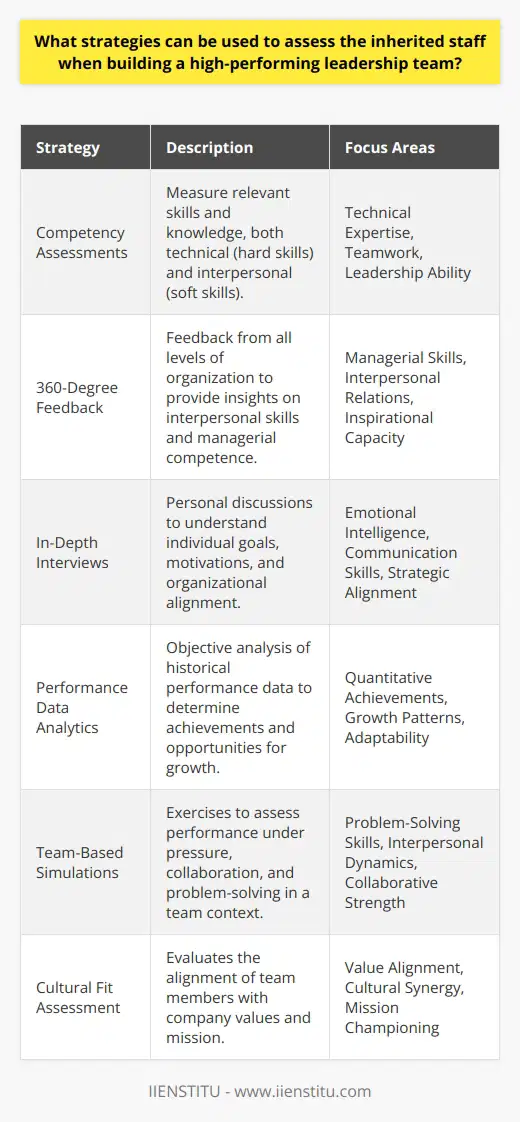
How can organizations design a future-ready organization to ensure long-term success?
Organizations today must strive to remain competitive in the ever-evolving business landscape. To do so, they must design a future-ready organization that can anticipate and respond to changes in the external environment. This can be achieved by implementing a comprehensive strategy focusing on long-term success.
Organizations should focus on developing a culture of learning and innovation. This requires a focus on skills development and knowledge management, enabling the organization to stay ahead of the curve regarding emerging trends and technologies. Additionally, organizations must ensure that their employees are kept abreast of the latest developments and equipped with the necessary skills to take advantage of opportunities.
Organizations must also focus on developing a flexible and agile organizational structure. This will enable them to quickly adapt to changes in the external environment and capitalize on emerging opportunities. Additionally, organizations should strive to create a culture that embraces change and encourages experimentation and innovation. Such an organizational culture will enable organizations to remain competitive in the long term.
Finally, organizations must invest in digital transformation. This includes investing in the latest technologies and digital solutions that will enable the organization to remain competitive. Additionally, organizations should strive to create a data-driven culture that leverages insights gained through data analysis to make informed decisions.
Organizations can ensure long-term success and remain competitive in the ever-evolving business landscape by implementing these strategies. Organizations should strive to create a future-ready organization that can anticipate and respond to external changes and capitalizes on emerging opportunities. This will enable them to remain competitive in the long term.
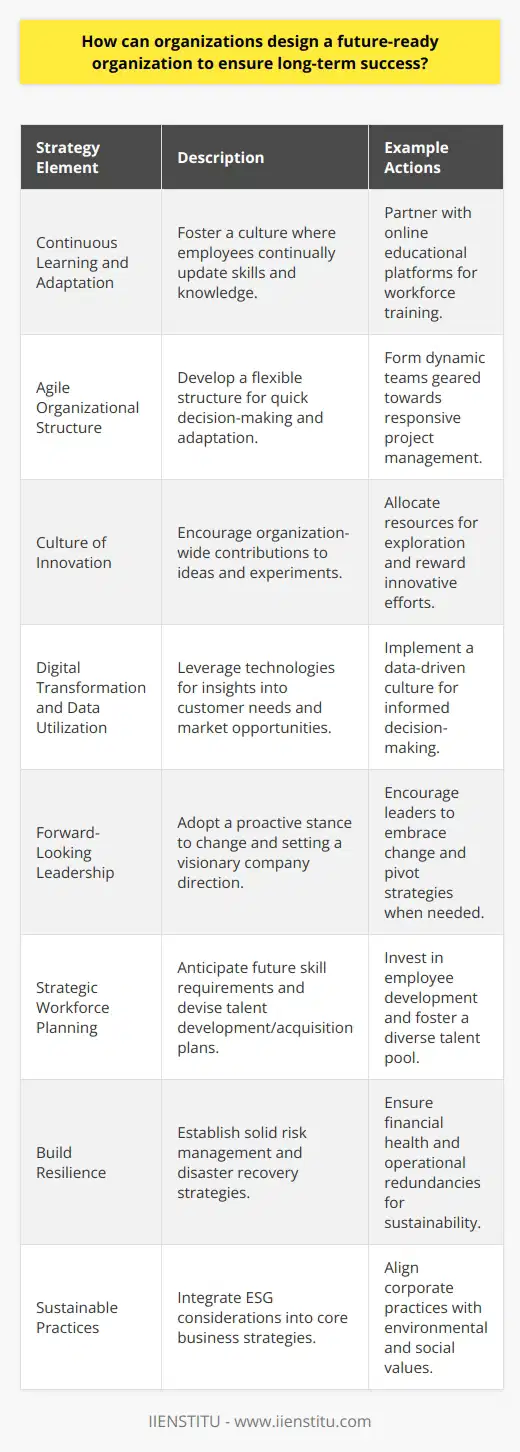
What are the potential time-talent trade-offs that should be considered when building a high-performing team?
The success of any team depends on how efficiently its members work together, and the potential time-talent trade-offs that should be considered when building a high-performing team are integral to its success. To create a productive and successful team, it is essential to consider the team member's strengths and weaknesses and consider how their skills can be used to maximize their collective potential.
One of the most critical considerations in a time-talent trade-off is the time each team member can commit to the team. A team composed of members who can devote a significant amount of time to the project is essential for ensuring that the team can reach its goals. The amount of time each team member can commit is also an essential factor in determining how the team can best utilize its collective talents.
In addition to the amount of time each team member can contribute, it is essential to consider the skills and abilities of each team member. Each team member should bring a set of skills that can help the team reach its goals. It is essential to consider how the skills of each team member can be used in a way that maximizes their collective potential. For example, if a team member has strong organizational skills, they may be better suited to take on tasks such as project coordination. In contrast, a member with solid research skills may be better suited to take on tasks such as data analysis.
Finally, it is crucial to consider the communication skills of each team member. Communication is essential for team success, and it is important to consider how each member's communication skills can be used to ensure that the team can work together effectively. For example, team members should be aware of how they can communicate with each other and how to utilize these methods best to ensure that the team can reach its goals.
In conclusion, when building a high-performing team, it is essential to consider the potential time-talent trade-offs that can be made. It is crucial to consider the amount of time each team member can commit to the team, the skills and abilities of each team member, and the communication skills of each team member. Taking these factors into consideration can help ensure that the team can utilize its collective talents to maximize its potential for success.
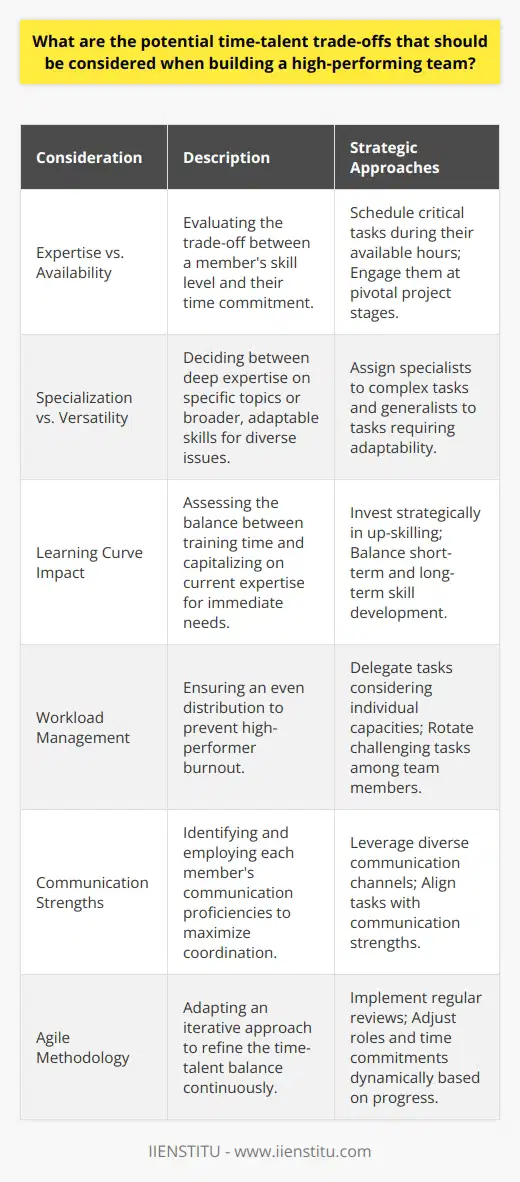
What are the key factors that contribute to the sustainability of high-performing teams in an organization?
Key Factors for Sustainable High-Performing Teams
Shared Vision and Goals
A crucial factor for high-performing teams' sustainability is establishing a shared vision that guides the team's actions and decisions. By defining clear goals, team members can align their individual efforts with the organization's objectives, ensuring that they are working towards the same end-result. This shared understanding fosters a sense of unity and facilitates collaboration, further enhancing the team's performance.
Effective Communication
Effective communication is essential as it enables team members to share ideas, offer feedback, and build trust. Open and transparent communication ensures that everyone is on the same page, reduces misunderstandings, and facilitates problem-solving. By fostering an environment where every member feels comfortable sharing their thoughts and opinions, teams can easily discover innovative solutions and continuously improve their performance.
Strong Leadership
High-performing teams require strong leadership that inspires, motivates, and supports team members in accomplishing their goals. Effective leaders provide clear direction, delegate tasks efficiently, and offer guidance, as needed. Furthermore, they empower team members and help them develop new skills, maintaining a sense of motivation and commitment to their work.
Diverse Abilities and Skills
The sustainability of high-performing teams also depends on the diversity of abilities and skills among team members. A mix of various strengths, talents, and expertise allows teams to tackle complex projects and innovate effectively. It is essential for organizations to foster a culture of inclusion and support that appreciates and enhances diversity, capitalizing on this variety of skills and knowledge.
Adaptability and Resilience
Lastly, adaptability and resilience contribute to the sustainability of high-performing teams. In today's rapidly changing business environment, teams must quickly adapt to new challenges and circumstances. Building resilience among team members enables them to respond positively to change, overcome setbacks, and learn from their experiences.
In conclusion, the sustainability of high-performing teams depends on multiple factors, including shared vision and goals, effective communication, strong leadership, diverse abilities and skills, and adaptability and resilience. By focusing on these components, organizations can not only enhance team performance but also ensure the long-term success of their teams in achieving their objectives.
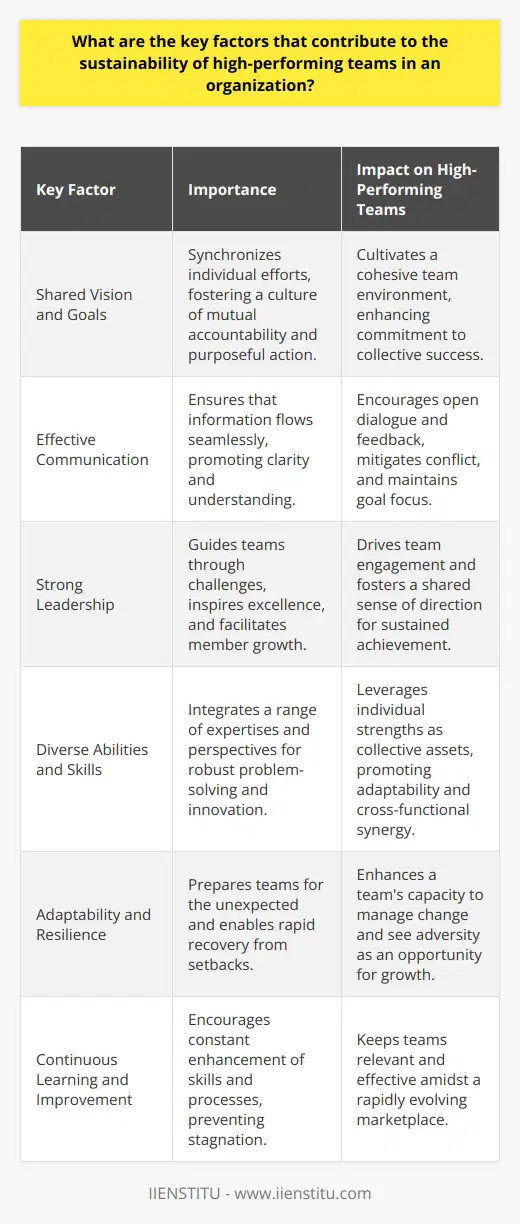
How can organizations effectively measure the performance and productivity of high-performing teams, and what methods of evaluation should be used to determine their ongoing success?
Evaluating Team Performance Metrics
Organizations can effectively measure the performance and productivity of high-performing teams via key performance indicators (KPIs). These invaluable tools enable businesses to assess whether teams are on the ladders of success or if improvements must be incorporated. In particular, there are vital performance metrics that organizations should implement in the evaluation process.
Utilizing SMART Goals
First and foremost, organizations must establish specific, measurable, achievable, relevant, and time-bound (SMART) goals. These goals enable teams to align their efforts towards a common target, which can be monitored and evaluated. Subsequently, performance reviews can be conducted to assess the team's success in achieving these goals.
Assessing Task Completion Rates
Another essential method for measuring team performance and productivity is by analyzing task completion rates. This allows organizations to track progress in real-time and promptly address issues that hinder team performance. A well-designed project management tool can assist in monitoring individual and team tasks, deadlines, and overall progress.
Monitoring Employee Engagement
Employee engagement is crucial for the success of high-performing teams, as engaged employees are likely to be more motivated and committed to achieving set goals. Evaluating employee engagement can involve the use of surveys or assessment tools to identify factors contributing to or impeding team performance and productivity.
Evaluating Communication and Collaboration
Effective communication and collaboration are foundations for high-performing teams. Evaluating these aspects helps businesses understand how well team members work together, share ideas, and achieve desired outcomes. Tools such as 360-degree feedback, team assessments, or meetings can be used to gain insight into the communication and collaboration dynamics of the team.
Measuring Individual Performance
Individual performance can influence team performance and should be assessed via regular performance reviews, feedback sessions, and goal-setting activities. An understanding of each team member's strengths and weaknesses allows organizations to make informed decisions on how to optimize team productivity and address areas of improvement.
Continuous Improvement Process
To effectively assess the ongoing success of high-performing teams, organizations must implement a continuous improvement process. This involves regularly reviewing performance data, setting new goals, and continuously optimizing team dynamics to foster a culture of continuous growth and development.
In conclusion, effectively measuring the performance and productivity of high-performing teams involves utilizing SMART goals, assessing the rate of task completion, monitoring employee engagement, and evaluating communication and collaboration. Additionally, individual performance and continuous improvement processes must be incorporated to ensure the ongoing success of teams in organizations.
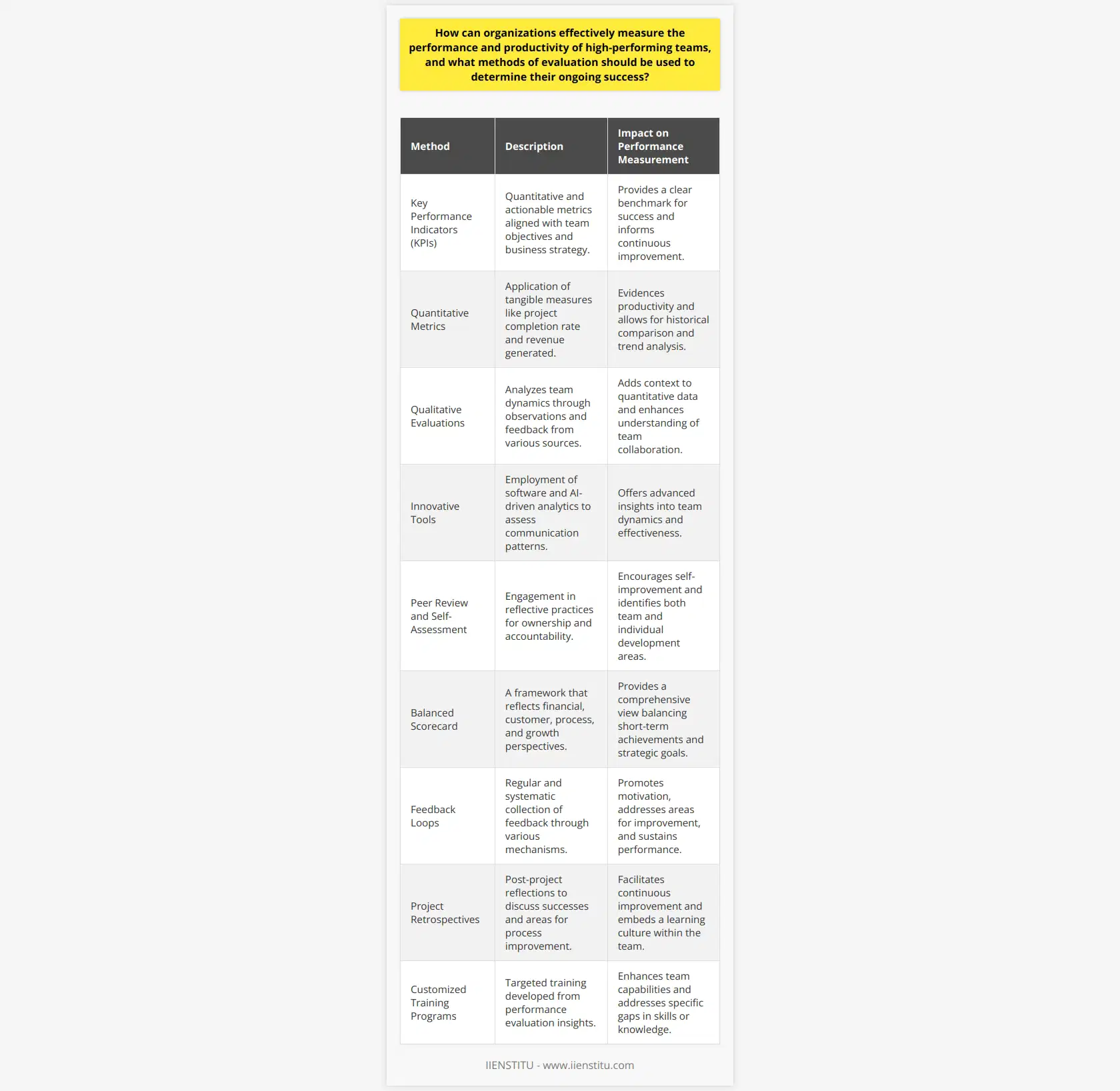
What are the critical components of communication and collaboration in high-performing teams, and how can leaders foster these aspects to ensure long-term success?
Importance of Communication and Collaboration
The critical components of communication and collaboration within high-performing teams include creating an environment of trust, ensuring clarity of roles, embracing diversity, holding open discussions, and establishing effective channels of communication. Leaders play a crucial role in fostering these aspects to ensure long-term success of team projects.
Trust and Clarity of Roles
Building an environment of trust is essential to encourage team members to share ideas, voice concerns, and work collaboratively. Leaders can achieve this by leading by example, being transparent in their actions, and providing consistent encouragement. It is equally important to ensure clarity of roles within the team, allowing members to understand their individual responsibilities, which leaders can facilitate by assigning tasks according to individual strengths and interests.
Embracing Diversity and Open Discussions
Embracing diversity among team members brings in different perspectives, which can lead to creative and innovative solutions. Leaders must be aware of cultural differences and promote an environment of respect and inclusivity, supporting the open exchange of ideas. In this context, fostering open discussions by conducting regular team meetings, inviting opinions from every member, and actively listening, allows for effective collaboration and the construction of a shared team vision.
Channels of Communication
Establishing effective channels of communication is essential for smooth functioning of high-performing teams. As a leader, it is essential to encourage regular check-ins, both individually and as a group, to facilitate clear and efficient exchange of information. The use of appropriate tools, like email, project management software, and team messaging platforms, can also bolster team communication and collaboration.
In conclusion, fostering the critical components of communication and collaboration within high-performing teams through trust, clarity of roles, embracing diversity, open discussions, and effective communication channels is key to ensuring long-term success. Only through these concerted efforts can leaders build a cohesive and efficient team capable of achieving their goals.
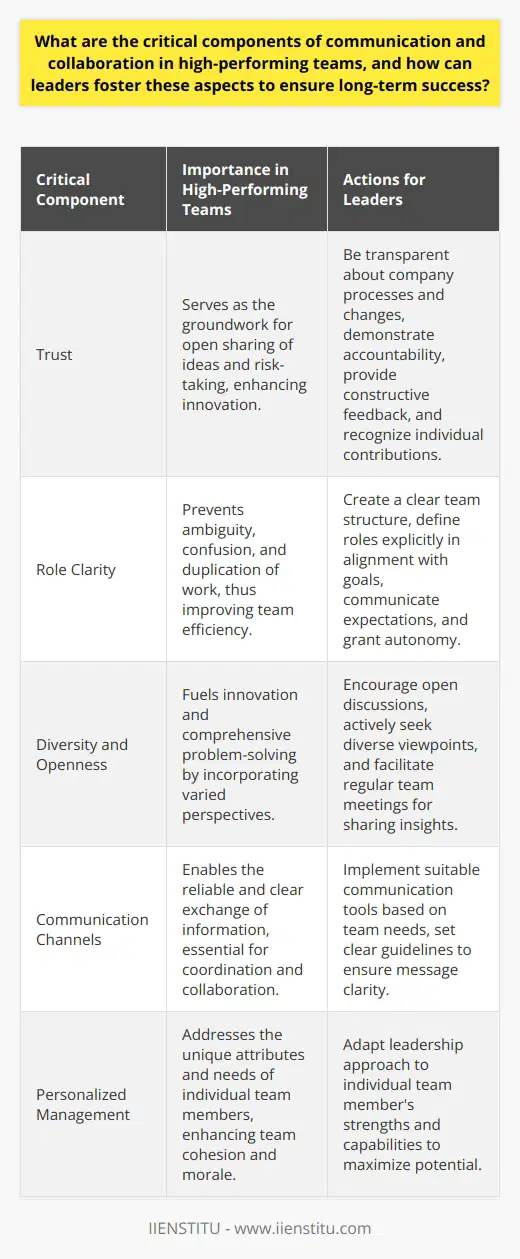
How does a high-performing team's decision-making process differ from that of an average team, and what factors contribute to improved decision-making in high-performing teams?
Distinct Decision-Making Processes
High-performing teams display a significantly different decision-making process compared to average teams. The primary difference lies in their consistent focus on achieving shared goals through collaborative efforts, open communication, and effective conflict resolution. In contrast, average teams often struggle with these elements, leading to subpar performance and disjointed decisions.
Crucial Factors Enhancing Decision-Making
Several factors contribute to improved decision-making in high-performing teams, with some of the most critical ones highlighted below.
Clear Roles and Responsibilities: High-performing teams have well-defined roles and responsibilities, ensuring that each member knows what is expected of them, reducing confusion and increasing overall efficiency.
Diverse Perspectives: Diverse perspectives enable high-performing teams to consider multiple solutions, fostering creativity and innovation in the decision-making process. This diversity allows teams to identify potential risks and mitigate them more effectively.
Open Communication: High-performing teams practice open communication, fostering trust and ensuring that all relevant information is considered during decision-making. Team members openly share ideas and concerns, allowing for more informed decisions.
Effective Conflict Resolution: Conflicts are inevitable in any team setting, but high-performing teams handle them constructively. They use conflicts as opportunities for growth, emphasizing problem-solving and avoiding blame games.
Continuous Learning: High-performing teams constantly seek ways to improve their decision-making processes. They embrace feedback, reflect on past experiences, and apply their learnings to enhance future performance.
Shared Vision and Goals: A shared vision and clear goals align team members' efforts and provide a sense of purpose. High-performing teams work collaboratively towards these objectives, ensuring that their decisions contribute to overall success.
Conclusion
In summary, high-performing teams exhibit a distinct decision-making process compared to average teams, characterized by clear roles, diverse perspectives, open communication, effective conflict resolution, continuous learning, and a shared vision. These factors enable high-performing teams to make more informed decisions, drive innovation, and achieve exceptional results.
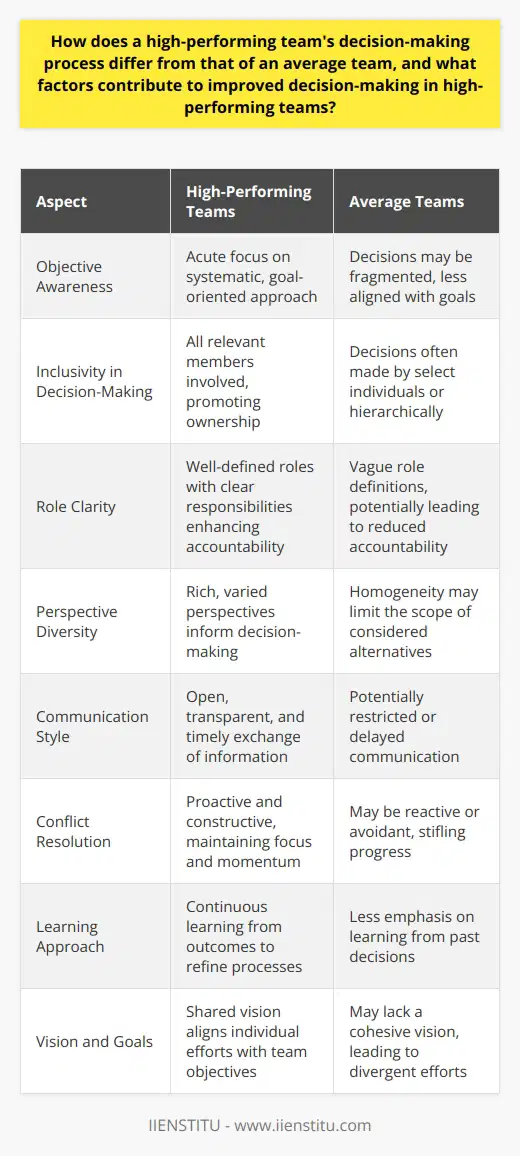
What are the most effective approaches to resolve conflict and maintain positive team dynamics in high-performing teams, and how can a leader facilitate these strategies for optimal team functioning?
Effective Communication Strategies
One effective approach to resolving conflict and maintaining positive team dynamics in high-performing teams is developing strong communication practices. Effective communication allows team members to openly express their thoughts, share ideas, and listen to others, thereby fostering a collaborative work environment. This, in turn, mitigates misunderstandings and prompts effective resolution of conflicts. Leaders can promote active listening skills by creating open channels for feedback and implementing regular team meetings, allowing for constructive, respectful dialogue.
Setting Clear Expectations
Establishing clear expectations is another key factor in maintaining positive team dynamics. Clearly outlining goals, objectives, and performance expectations enables team members to work towards a common vision. Additionally, setting team norms and behavioral expectations goes a long way in fostering an atmosphere of shared values and respect. Leaders play a crucial role in this by setting an example, making their expectations transparent, and holding regular performance reviews to ensure all members are aligned with the team's goals.
Embracing Diversity
Diversity is an essential ingredient within high-performing teams. Valuing different perspectives, experiences, and backgrounds leads to better decision-making and increased creativity. Leaders should embrace diversity as a strength, foster a culture of inclusion, and provide training and resources to educate their team on the benefits of diversity. Encouraging brainstorming sessions and team-building activities can also help build connections among diverse team members and channel their differences positively.
Encouraging Constructive Feedback
Encouraging a culture of constructive feedback helps prevent issues from escalating while also promoting continuous improvement. Constructive feedback allows team members to learn from their mistakes and strengthens their relationships, avoiding potential conflicts. Leaders can facilitate this by modeling effective feedback practices, ensuring that it is specific, timely, and solution-oriented. They can also schedule feedback sessions with their team members, where praise and constructive criticism are openly shared.
Conflict Management Techniques
When conflicts arise, employing effective conflict management techniques is crucial for maintaining positive team dynamics. Conflict resolution strategies such as active listening, compromising, and providing mediation or intervention as necessary ensure that issues are addressed promptly and fairly. Leaders should remain impartial, emphasizing problem-solving and mutually beneficial solutions, rather than determining the 'winner' or 'loser' in any given situation.
In conclusion, leaders play a critical role in promoting effective communication, setting clear expectations, embracing diversity, encouraging constructive feedback, and employing conflict management techniques for optimal team functioning. By facilitating these strategies, they can ensure the resolution of conflicts and maintain positive team dynamics within their high-performing groups.
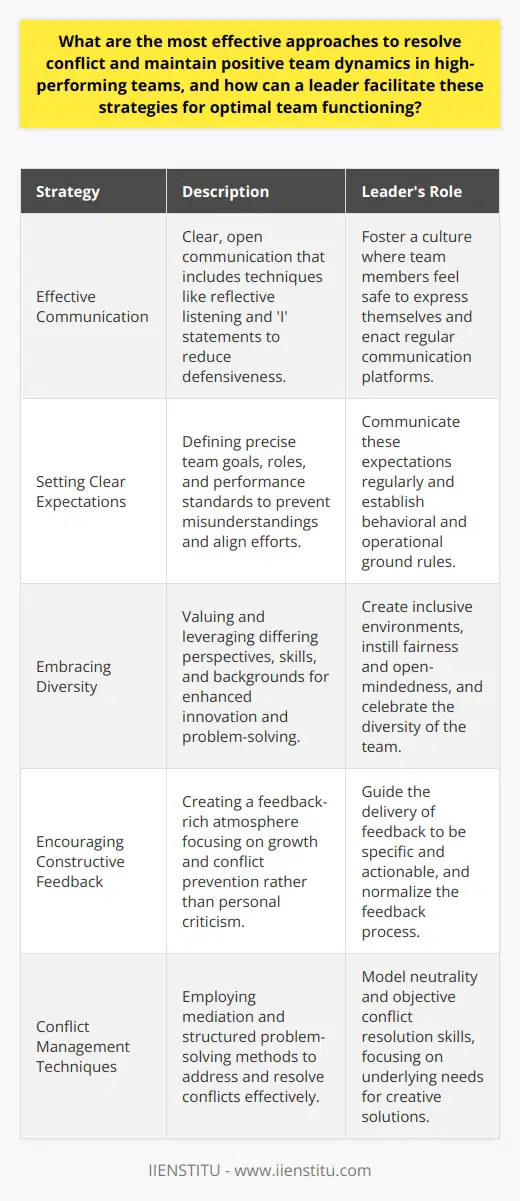
What is the best leadership style for a high-performing team?
**Understanding High-Performing Teams**
A high-performing team is characterized by its outstanding performance, high productivity, and consistent delivery of exceptional results. Such teams exhibit superior communication, collaboration, and problem-solving abilities. To identify the best leadership style for such a team, it is crucial to first comprehend their unique characteristics.
**Transformational Leadership Style**
Transformational leadership is the most effective style for leading high-performing teams. This approach enables leaders to inspire and motivate team members by setting a clear vision and objectives, fostering open communication, and promoting innovation. These qualities are critical for sustaining the high-performance levels of the team.
**Inspiring Vision and Goals**
High-performing teams thrive when their leaders provide a compelling vision that aligns with their personal goals and values. Transformational leaders encourage team members to work towards shared objectives, which enhances individual commitment and promotes collaboration.
**Open Communication and Feedback**
Effective leadership promotes transparent and open communication, allowing team members to share ideas, opinions, and concerns without fear of retribution. Transformational leaders welcome diverse perspectives and use constructive feedback to develop their team members' skills, foster growth, and drive the continuous improvement process.
**Encouraging Innovation and Taking Risks**
Innovation is crucial for the success of high-performing teams. Transformational leaders create a culture that encourages creativity and risk-taking, leveraging the exceptional skills of their team members to explore new solutions and approaches. This empowerment drives the team's adaptability and versatility in overcoming complex challenges.
**Developing Team Members' Potential**
A key aspect of transformational leadership is a focus on developing the potential of each team member. Leaders invest time in understanding the strengths, weaknesses, and aspirations of their team members, providing opportunities for personal and professional growth. This fosters a sense of loyalty and satisfaction within the high-performing team.
**Conclusion**
In conclusion, transformational leadership is the preferred style for managing high-performing teams. This approach encompasses inspiring vision and goals, fostering open communication and feedback, encouraging innovation, and developing team members' potential. Adherence to this leadership style empowers and motivates team members, sustaining their outstanding performance and ensuring the team's continued success.
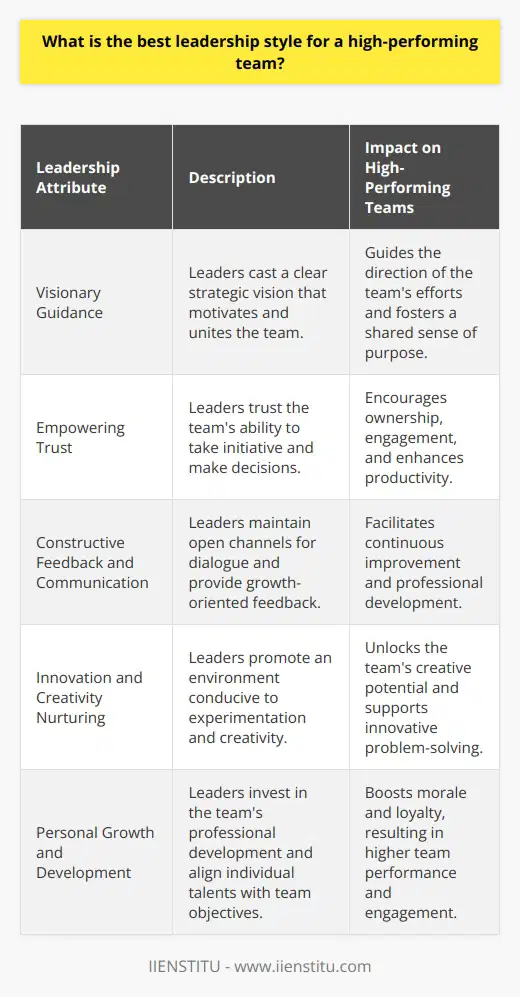
How do leaders create high performing teams while managing a diverse group of individuals with different skill sets and backgrounds?
Creating Inclusive Environments
Leaders foster high performing teams by cultivating inclusive environments that respect and value the unique perspectives of individuals from different backgrounds and with varying skill sets. They actively establish a safe and supportive atmosphere where team members feel comfortable expressing and exchanging diverse thoughts and ideas.
Setting Clear Goals and Establishing Expectations
To further enhance performance, leaders define clear goals and establish explicit expectations for their teams. This includes outlining roles and responsibilities, communicating the importance of collaboration, and highlighting how each member's unique abilities contribute to the team's overall success. By setting a clear direction and a shared vision, team members understand how their individual efforts contribute to both the group's and organization's objectives.
Embracing and Leveraging Diversity
Exceptional leaders appreciate the benefits of diversity in teams, recognizing that a mix of backgrounds and skills fosters greater innovation, creativity, and problem-solving capabilities. They actively seek input from all members and encourage the sharing of skills, knowledge, and expertise through mentoring, cross-training, and skill-sharing opportunities. This approach not only enhances individual and team performance but fosters an atmosphere of mutual respect and trust among team members.
Providing Regular Feedback and Recognition
High-performing teams thrive on receiving regular feedback and recognition from their leaders. By offering constructive feedback on performance, acknowledging individual and team achievements, and celebrating success, leaders foster a culture of continuous improvement where team members feel motivated to contribute to their fullest potential.
Encouraging Open Communication and Accountability
Finally, leaders of high-performing teams encourage open communication and foster a sense of accountability among team members by holding regular team meetings and check-ins. In these forums, team members can discuss progress, raise concerns, and ask for support, creating a culture of transparency where each team member feels responsible for their contributions and accountable to their peers.
In summary, leaders drive high-performing teams by establishing an inclusive environment, setting clear goals, embracing diversity, providing regular feedback, and promoting open communication and accountability. Through these efforts, leaders not only optimize individual performance but also foster stronger, more effective teams that are equipped to excel in complex and dynamic organizational environments.
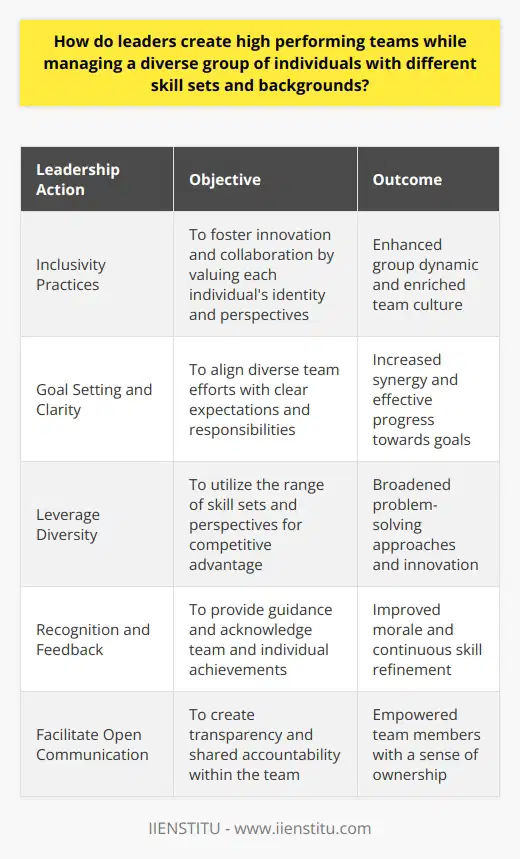
What are 5 important elements for building high-performing teams that can adapt and thrive in ever-changing environments?
Key Elements for High-Performing Teams
Diverse Expertise and Skills
One essential component of high-performing teams is the diversity of expertise and skills among team members. A broad range of abilities and knowledge bases allows the team to tackle complex problems from multiple perspectives, increasing the probability of finding innovative solutions.
Effective Communication
Effective communication is critical for teams to function efficiently and adapt to shifting environments. Establishing clear channels for exchanging ideas, asking questions, and providing timely feedback promotes a culture of collaboration and generates a shared understanding of the team's goals and objectives.
Shared Leadership
High-performing teams benefit from shared leadership – a process in which team members assume leadership roles in accordance with their evolving skills and the shifting demands of the project. This adaptability enables the team to respond more effectively to changes and capitalize on emerging opportunities.
Positive Team Atmosphere
A positive team atmosphere, marked by trust, respect, and mutual support, is crucial for fostering high performance. Such an environment encourages team members to take risks, engage in open and honest discussions, and contribute fully to the team's efforts. Moreover, strong interpersonal relationships enhance team cohesion and resilience in the face of challenges.
Continuous Learning and Development
Lastly, high-performing teams must be committed to continuous learning and development. By seeking out opportunities for skill-building and learning from both successes and setbacks, team members can continually refine their abilities and grow together as a unit. This growth mindset equips the team with the skills and adaptability necessary to flourish amid the ever-evolving demands of their environment.
